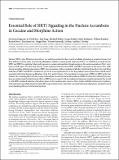Essential Role of SIRT1 Signaling in the Nucleus Accumbens in Cocaine and Morphine Action
Author(s)
Ferguson, Deveroux; Koo, Ja Wook; Feng, Jian; Heller, Elizabeth; Rabkin, Jacqui; Heshmati, Mitra; Renthal, William; Neve, Rachael L.; Liu, Xiaochuan; Shao, Ningyi; Sartorelli, Vittorio; Shen, Li; Nestler, Eric J.; ... Show more Show less
DownloadFerguson-2013-Essential Role of SI.pdf (2.240Mb)
PUBLISHER_POLICY
Publisher Policy
Article is made available in accordance with the publisher's policy and may be subject to US copyright law. Please refer to the publisher's site for terms of use.
Terms of use
Metadata
Show full item recordAbstract
Sirtuins (SIRTs), class III histone deacetylases, are well characterized for their control of cellular physiology in peripheral tissues, but their influence in brain under normal and pathological conditions remains poorly understood. Here, we establish an essential role for SIRT1 and SIRT2 in regulating behavioral responses to cocaine and morphine through actions in the nucleus accumbens (NAc), a key brain reward region. We show that chronic cocaine administration increases SIRT1 and SIRT2 expression in the mouse NAc, while chronic morphine administration induces SIRT1 expression alone, with no regulation of all other sirtuin family members observed. Drug induction of SIRT1 and SIRT2 is mediated in part at the transcriptional level via the drug-induced transcription factor ΔFosB and is associated with robust histone modifications at the Sirt1 and Sirt2 genes. Viral-mediated overexpression of SIRT1 or SIRT2 in the NAc enhances the rewarding effects of both cocaine and morphine. In contrast, the local knockdown of SIRT1 from the NAc of floxed Sirt1 mice decreases drug reward. Such behavioral effects of SIRT1 occur in concert with its regulation of numerous synaptic proteins in NAc as well as with SIRT1-mediated induction of dendritic spines on NAc medium spiny neurons. These studies establish sirtuins as key mediators of the molecular and cellular plasticity induced by drugs of abuse in NAc, and of the associated behavioral adaptations, and point toward novel signaling pathways involved in drug action.
Date issued
2013-10Department
Massachusetts Institute of Technology. Department of Brain and Cognitive SciencesJournal
Journal of Neuroscience
Publisher
Society for Neuroscience
Citation
Ferguson, D., J. W. Koo, J. Feng, E. Heller, J. Rabkin, M. Heshmati, W. Renthal, et al. “Essential Role of SIRT1 Signaling in the Nucleus Accumbens in Cocaine and Morphine Action.” Journal of Neuroscience 33, no. 41 (October 9, 2013): 16088–16098.
Version: Final published version
ISSN
0270-6474
1529-2401